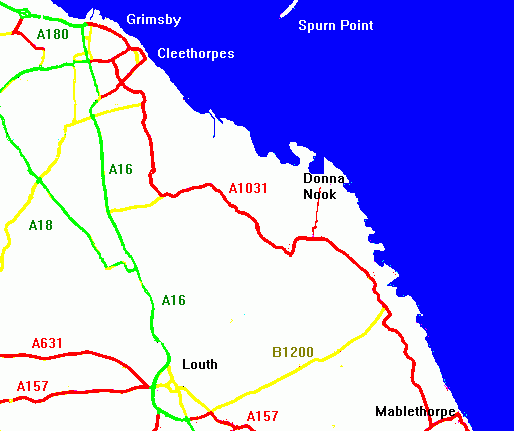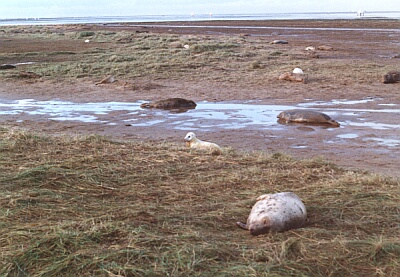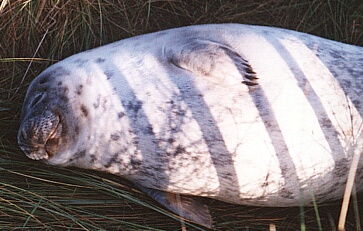
Donna Nook is one of the most accessible sites for seeing seals at a time of breeding in the UK. Elsewhere they either gather on beaches but in far away places like the Scottish islands, or they are out to sea in rocky outcrops. In Lincolnshire it is a short ride from near Louth to the beach and there they are, in late autumn and early winter.

 The area is near an RAF bombing range, which though noisy has acted as protection while the colony got established from the early 1970s. They started over a mile out across the mud on the sandbank but presently most are born on the edge of the dunes. The noise and activity doesn't affect them. The RAF sometimes will remove a seal in danger to where most of them congregate, which is out of danger. During the winter months, there is supervision because the public now take a look.
The area is near an RAF bombing range, which though noisy has acted as protection while the colony got established from the early 1970s. They started over a mile out across the mud on the sandbank but presently most are born on the edge of the dunes. The noise and activity doesn't affect them. The RAF sometimes will remove a seal in danger to where most of them congregate, which is out of danger. During the winter months, there is supervision because the public now take a look.
The grey (or Atlantic) seal occurs on both sides of the North Atlantic. They are not confined to the Atlantic either because they come to Lincolnshire. The grey is one of two species of seal which breed around Britain, the other being the common or harbour seal.
 The seal is a mammal and they are the next largest around Britain after the whale. Adult males are about two and a half yards long and weigh 36 stones (but may reach up to 50 stones); females are about 2 yards long and 25 stones.
The seal is a mammal and they are the next largest around Britain after the whale. Adult males are about two and a half yards long and weigh 36 stones (but may reach up to 50 stones); females are about 2 yards long and 25 stones.
Grey seals in Britain make up around 50% of the world population and are found mainly around the exposed rocky northern and western coasts, particularly uninhabited islands in the Hebrides and Orkney. Coming to sandbanks or sandy beaches, as at Donna Nook, is relatively unusual.
Donna Nook is safe. It has the best statistics for pup survivals. Between fifteen and twenty five per cent of pups die but can be forty per cent on crowded or wave-swept beaches.
Females (called cows) may start breeding as young as three years old, and go on doing so for 25 years. Males are ready when six but need experience to gain a position among a breeding group when they are ten and better experienced.
Males (called bulls) come ashore and compete for a position within collections of breeding cows. Prime bulls can stay for five to six weeks without feeding to be around to impregnate females. They have no role in bringing up pups.
At Donna Nook breeding starts late in November. This compares with September in Wales and October in western Scotland. The pups are gone into the new year.
Pups put on weight very quickly, feeding on their mother's (called cows) fat-rich milk. Over just eighteen days they triple their weight (the suckling period). Cows stay with their pups during this period and do not feed, so they lose about 10lb in weight each day.
As a cow completes feeding one pup, along comes a nearby male and impregnates the female. The female then leaves the pup which lives off the feeding it had received. During about a week the white natal fur is moulted and the first adult coat appears.
Bulls are generally dark with few pale patches. One can recognise an adult male by its high arched ‘Roman´ nose. Females (called cows) tend to be paler, with dark patches scattered about on the pale background.
Grey seals spend two thirds of their time out at sea, hunting and feeding. Adults eat about 11lb of fish a day each. At Donna Nook Dover sole and sand eel are the staple diet although seals are opportunistic feeders and take what is most plentiful.
Then they come back from the sea to gather in large groups on remote beaches and uninhabited islands. There can be several hundred especially at the spring moult.
The longest known living bull was twenty nine but most don't live beyond twenty five. Females do better: the oldest female known about was forty six (at Shetland). Most do not live beyond thirty five.
Source: literature from Donna Nook